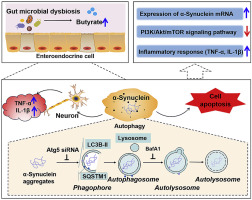当前位置:
X-MOL 学术
›
Exp. Cell Res.
›
论文详情
Our official English website, www.x-mol.net, welcomes your
feedback! (Note: you will need to create a separate account there.)
Sodium butyrate causes α-synuclein degradation by an Atg5-dependent and PI3K/Akt/mTOR-related autophagy pathway.
Experimental Cell Research ( IF 3.3 ) Pub Date : 2019-12-10 , DOI: 10.1016/j.yexcr.2019.111772 Chen-Meng Qiao 1 , Meng-Fei Sun 1 , Xue-Bing Jia 1 , Yun Shi 1 , Bo-Ping Zhang 1 , Zhi-Lan Zhou 1 , Li-Ping Zhao 1 , Chun Cui 1 , Yan-Qin Shen 1
Experimental Cell Research ( IF 3.3 ) Pub Date : 2019-12-10 , DOI: 10.1016/j.yexcr.2019.111772 Chen-Meng Qiao 1 , Meng-Fei Sun 1 , Xue-Bing Jia 1 , Yun Shi 1 , Bo-Ping Zhang 1 , Zhi-Lan Zhou 1 , Li-Ping Zhao 1 , Chun Cui 1 , Yan-Qin Shen 1
Affiliation

|
Aggregation of α-Synuclein is central to the pathogenesis of Parkinson's disease (PD). However, these α-Synuclein inclusions are not only present in brain, but also in gut. Enteroendocrine cells (EECs), which are directly exposed to the gut lumen, can express α-Synuclein and directly connect to α-Synuclein-containing nerves. Dysbiosis of gut microbiota and microbial metabolite short-chain fatty acids (SCFAs) has been implicated as a driver for PD. Butyrate is an SCFA produced by the gut microbiota. Our aim was to demonstrate how α-Synuclein expression in EECs responds to butyrate stimulation. Interestingly, we found that sodium butyrate (NaB) increases α-Synuclein mRNA expression, enhances Atg5-mediated autophagy (increased LC3B-II and decreased SQSTM1 (also known as p62) expression) in murine neuroendocrine STC-1 cells. Further, α-Synuclein mRNA was decreased by the inhibition of autophagy by using inhibitor bafilomycin A1 or by silencing Atg5 with siRNA. Moreover, the PI3K/Akt/mTOR pathway was significantly inhibited and cell apoptosis was activated by NaB. Conditioned media from NaB-stimulated STC-1 cells induced inflammation in SH-SY5Y cells. Collectively, NaB causes α-Synuclein degradation by an Atg5-dependent and PI3K/Akt/mTOR-related autophagy pathway.
中文翻译:

丁酸钠通过依赖Atg5的PI3K / Akt / mTOR相关自噬途径引起α-突触核蛋白降解。
α-突触核蛋白的聚集对于帕金森氏病(PD)的发病机理至关重要。然而,这些α-突触核蛋白包涵体不仅存在于大脑中,而且也存在于肠道中。直接暴露于肠腔的肠内分泌细胞(EEC)可以表达α-突触核蛋白并直接连接到含α-突触核蛋白的神经。肠道菌群和微生物代谢产物短链脂肪酸(SCFA)的营养不良被认为是PD的驱动因素。丁酸盐是肠道菌群产生的SCFA。我们的目的是证明EECs中α-突触核蛋白的表达如何响应丁酸酯刺激。有趣的是,我们发现丁酸钠(NaB)在鼠神经内分泌STC-1细胞中增加了α-突触核蛋白mRNA的表达,增强了Atg5介导的自噬(LC3B-II的增加和SQSTM1(也称为p62)的表达的减少)。进一步,通过使用抑制剂bafilomycin A1抑制自噬或通过将Atg5与siRNA沉默来抑制α-突触核蛋白mRNA的表达。而且,PI3K / Akt / mTOR途径被NaB显着抑制,细胞凋亡被激活。NaB刺激的STC-1细胞的条件培养基诱导SH-SY5Y细胞发炎。总的来说,NaB通过依赖Atg5的PI3K / Akt / mTOR相关自噬途径引起α-突触核蛋白降解。
更新日期:2019-12-11
中文翻译:

丁酸钠通过依赖Atg5的PI3K / Akt / mTOR相关自噬途径引起α-突触核蛋白降解。
α-突触核蛋白的聚集对于帕金森氏病(PD)的发病机理至关重要。然而,这些α-突触核蛋白包涵体不仅存在于大脑中,而且也存在于肠道中。直接暴露于肠腔的肠内分泌细胞(EEC)可以表达α-突触核蛋白并直接连接到含α-突触核蛋白的神经。肠道菌群和微生物代谢产物短链脂肪酸(SCFA)的营养不良被认为是PD的驱动因素。丁酸盐是肠道菌群产生的SCFA。我们的目的是证明EECs中α-突触核蛋白的表达如何响应丁酸酯刺激。有趣的是,我们发现丁酸钠(NaB)在鼠神经内分泌STC-1细胞中增加了α-突触核蛋白mRNA的表达,增强了Atg5介导的自噬(LC3B-II的增加和SQSTM1(也称为p62)的表达的减少)。进一步,通过使用抑制剂bafilomycin A1抑制自噬或通过将Atg5与siRNA沉默来抑制α-突触核蛋白mRNA的表达。而且,PI3K / Akt / mTOR途径被NaB显着抑制,细胞凋亡被激活。NaB刺激的STC-1细胞的条件培养基诱导SH-SY5Y细胞发炎。总的来说,NaB通过依赖Atg5的PI3K / Akt / mTOR相关自噬途径引起α-突触核蛋白降解。











































 京公网安备 11010802027423号
京公网安备 11010802027423号